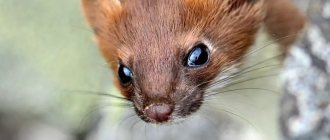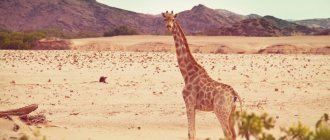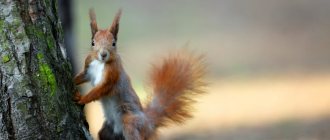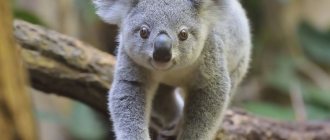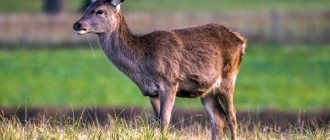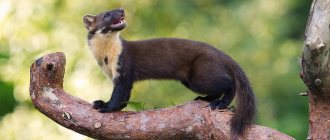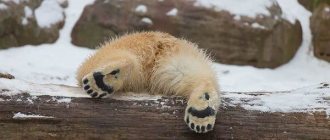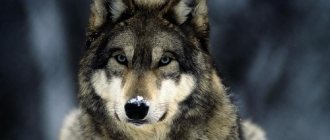Welcome, dear readers, to our website!
Here you can find out many interesting and incendiary stories, many facts and explanations about the world. On our website you will find a lot of useful and interesting information from various fields of science, sports, nature, animals and much more. Read and share with friends!
In this article we will find out - is a Panda a bear?
The giant panda is a member of the Bear family. These funny bears will make you smile! In this article you will find a detailed description and photo of a giant panda, and you will be able to learn a lot of new and fascinating things about the life of this rare animal.
Beautiful legend
The charming black and white bear cub has earned fame and love all over the world. There is an ancient legend in China that explains the panda's coloring.
According to this legend, once upon a time, a family of shepherds settled on the slopes of the mountains. Every day, the shepherds took a flock of sheep to the pasture, where a little panda came to play with them. But one day a leopard attacked the sheep.
The sheep ran away, but the little bear cub could not run fast and did not have time to hide. And he could not escape death. But the young shepherdess took a stick and drove the leopard away from the little bear cub, and she herself died from the claws of the terrible beast.
Having learned about this, the pandas began to cry and sprinkled themselves with ashes as a sign of mourning for the brave girl. Wiping away tears, they left black spots on their snow-white skin. Since then, the panda skin has been a mourning for the dead girl.
Is a panda a raccoon?
Because of this similarity, the two species of animals are called pandas. But here the consensus among scientists ends. Some scientists argue that the giant panda is a type of bear, others say that the red panda is a type of raccoon, and still others believe that the giant and red pandas form a special order of mammals - pandas.
The giant panda generally confuses scientists. The panda runs at a trot, and not at a gallop, like a regular bear. The panda does not know how to growl, but bleats like a sheep.
However, by studying the blood cells and other cells of the giant panda and comparing them with the cells of ordinary bears, scientists came to the conclusion that giant pandas are still bears that have adapted to life in the highlands of China, Nepal and Tibet.
It has been suggested that bears, raccoons and red pandas have a common ancestor - an animal that lived 20-40 million years ago, which explains the similarity of raccoons, bears and pandas. True, raccoons and red pandas evolved in one direction, and bears, including the giant panda, in another. The giant panda lives in dense forests at altitudes of 1.5 to 3 kilometers, feeding on bamboo that grows around trees on mountain slopes.
The giant panda is very gluttonous. She eats about 10 kilograms of bamboo leaves and trunks and about 40 kilograms of tasty young bamboo shoots per day. But no one thinks that pandas are like pigs.
Pandas cannot, like cows, digest cellulose, a fiber found in bamboo and other plants. Therefore, in order to extract as many nutrients as possible from its “wooden” food, the panda is forced to spend all the time that it is not sleeping, busily working with its jaws, chewing bamboo.
Red pandas also live in Asia, but not so high; they live at the foot of the Himalayan mountains. Like giant pandas, red pandas feed primarily on bamboo, but vary their diet with fruits, nuts and sometimes small animals. A giant panda gives birth to one cub per litter. Like cubs, panda cubs are born cute and small.
Fun fact: Instead of galloping and growling like a real bear, the panda trots and bleats like a sheep.
Habitat
The giant panda lives in one single country - China. She lives in mountainous regions such as Tibet and Sichuan. She can also be seen in some zoos in other countries that have rented the panda. Rental costs reach up to a million dollars a year. All cubs born in captivity are considered the property of China. Scientists believe that there are approximately 2,000 Giant Pandas left.
Description
A giant panda is a bear with a peculiar coloring - black and white. The back and belly are white. All paws are dark in color. Their head is white with black ears and spots around the eyes. She conquered the whole world with her appearance. One day in 1869, a traveler, zoologist Armand David, brought from China to the Museum of Natural History, located in Paris, the skin of an unusual animal that looked like a bear.
He bought it from the residents of Sichuan province, who told him that it belonged to a real animal “bei-shungu” (translated as polar mountain bear) living in the mountains. Looking at this amazing skin, everyone had the impression that in front of them lay two skillfully sewn pieces of different colors. Scientists were never able to find traces of gluing and sewing. There was even a version that the skin was simply painted.
Later, the traveler managed to buy a killed “bey-shunga” from hunters and send it to Paris for research. Having studied the structure and lifestyle of this animal, it was originally called a bamboo bear. Pandas reach a length of 1.2 to 1.8 meters.
Their weight does not exceed 160 kg. Males are always larger than females. Their body is massive, their claws are sharp. They are distinguished from all other mammals by the presence of six toes on their paws. In fact, the sixth thumb cannot be called a finger.
This is just an enlarged sesamoid bone. For other bears it is very small. Thanks to this developed “finger,” pandas can hold bamboo. The closest relative of pandas is considered to be the spectacled bear living in South America.
Lifestyle, behavior
The giant panda is highly secretive. She is in no hurry to show herself to people, preferring a solitary lifestyle in the wild. For a very long time she managed not to tell anything about herself.
And the person knew little about her. The gaps began to be filled when people became seriously concerned about the almost extinct species of bear and began to create protective reserves for it. Following the habits of the bamboo bear, now in his field of vision, the man learned a lot of interesting things about him.
The giant panda is sedate and noble. He behaves importantly, even arrogantly, and walks leisurely. Behind this calm grandeur lies a reasonable and peaceful disposition. But even a panda's love of peace has its limits. And no one should test their patience - neither their relatives nor humans.
This is interesting! A sense of “solidity” is given to the bamboo bear by its characteristic poses. He can often be seen sitting “as if in a chair” - leaning his back against some object and resting his front paw on a ledge. Not a bear, but a real bamboo king!
The giant panda is lazy. It seems that the slowness of the giant panda borders on laziness. There is a joke about this - they say that the panda is lazy to such an extent that it is too lazy to even reproduce. In fact, the panda has a strict energy reserve due to its low-calorie plant diet.
To get enough food, a panda has to eat almost constantly - 10-12 hours a day. The rest of the time she sleeps. Moreover, the panda is active at dawn and at night, and during the day he sleeps, stretching out somewhere in the shade.
All the energy that the giant panda gets from food is spent on its own production. It has been noticed that in captivity, where the bamboo bear does not have problems with food, it behaves more active and playful. Can stand on its head, somersault, climb grates and ladders.
Bamboo bears do not hibernate . In winter, they simply move to places where the air temperature is several degrees higher.
Giant pandas are loners . The exception is the breeding season, which is very short and occurs once every two years. The rest of the time, pandas protect their privacy, protecting their habitat from parishioners - other bamboo bears.
Scientists believe that this behavior is caused by the fact that two pandas cannot feed themselves in one area. Giant pandas are not builders, they do not make permanent burrows, preferring natural shelters - caves, trees. Pandas can swim, but they don’t like water - they hide from the rain, don’t go into the river unless necessary, and refuse to swim in the pool. But at the same time, giant pandas are very clean animals.
Panda mothers are gentle and caring . They are seen playing with their young for fun. Sometimes they wake up their babies just to play with them.
Giant pandas are not talkative. It is rare to hear their voice. Sometimes they make a sound similar to bleating.
And there is nothing to indicate that in an excited state this bear is capable of deafening “vocals.” He can “blow” so much that the glass in the windows shakes. He can also moo like a cow and even squeal.
Pandas are not hostile . They treat people without any aggression, quickly remember their name and are well tamed at a young age.
Population and species status
This animal is listed in the International Red Book as a species on the verge of extinction. There are no more than 2 thousand of them in the wild.
Nowadays, every animal counts, although during the Cultural Revolution in China, giant pandas were shot for their valuable fur.
After this, the Chinese state took serious measures to save this unique animal. In this country, you can go to the gallows for killing a panda. At the same time, nature reserves are being actively created. The problem also lies in the fact that in captivity the panda practically does not reproduce. If a panda baby is born in any zoo, then this is a global event.
You need to know this! The bamboo bear in China has the status of a national treasure. A local farmer who killed a panda in 1995 was given a life sentence.
Giant pandas are kept in many zoos around the world, in countries such as China, the USA, the UK, South Korea and Switzerland.
Panda diet
Giant pandas are “carnivorous vegetarians.” Despite the fact that they belong to the order of predators, their diet consists of 90% plant foods. Basically, it is bamboo.
They eat it in huge quantities. One adult needs at least 30 kg of bamboo per day to eat.
The giant panda gets the missing calories from other plants and fruits. It gets protein food from insects, bird eggs, fish and small mammals. Doesn't disdain carrion either. Return to content.
What does a grizzly bear eat?
Photo: Animal grizzly bear
Due to repeated attacks on people and livestock, the grizzly bear has a reputation as a cruel and merciless killer. However, this is not entirely true, and this type of predator objectively belongs to the category of omnivores. In ordinary life, when his aggressive behavior is not provoked by anything, the bear gives preference to plant foods: berries, roots, shoots and fruits of plants. In addition, these powerful animals happily feast on bird eggs, reptiles and their future offspring, frogs and insects.
For the coastal variety of grizzly bears, fish is a significant part of the daily diet. When the time comes for spawning, and the prey itself jumps out of the water, the tenacious paws of the predator with dexterity pick it up right on the fly.
As for large animals, most likely the grizzly will choose as prey an old and sick individual sika deer, ram, goat, or chamois, as well as inexperienced young animals of other forest inhabitants. According to popular belief, bears are great connoisseurs of honey. This is true, only this delicacy is available mostly to bear cubs, due to their small size and ability to climb trees.
The teeth of a gray bear have a specific shape and are intended for various types of food - both plant and animal. An adult needs to consume about 20 thousand kilocalories per day. Such an urgent need for food forces grizzlies to almost constantly be in a state of search for food, especially before hibernation.
Pregnancy in pandas
The panda is not an animal prone to lively mating games; they have a very low level of fertility. In the spring season, the mating season begins. The duration of pregnancy is 150-160 days.
After the set period, the female animal gives birth to a baby that is tiny in relation to the size of the mother. In rare cases, two babies are born. It is quite difficult to recognize these blind, small, almost hairless balls of future chic pandas.
The mother carefully protects her cub, which is prone to fairly rapid growth.
Kids are usually too active and very inquisitive. They are in constant search of adventure and entertainment.
The bamboo bear, as the animal is often called, is listed in the Red Book due to its small numbers. In China, the great giant panda symbolizes the national priceless treasure.
Newborn pandas
Newborn pandas are blind and hairless, weighing about 120 grams, the same as a can of tomato juice.
The little panda has brilliant prospects to increase his weight by 900 times within two to three years. Why are babies born so small? Scientists say that the problem lies in the growth characteristics of cubs before birth (while still in the womb). After fertilization of the egg occurs in the panda's body, it moves freely inside the uterus without attaching to its wall, as happens in most mammals.
Scientists believe that the body of bears and female giant pandas regulates the number of cubs so that it matches the amount of food available. If the mother bear cannot find enough food to feed herself and her cub during pregnancy, then the embryo will most likely not attach to the wall of the uterus and will not begin to grow. But if everything goes well, then the embryo is securely attached to the uterus.
This usually occurs at 4-6 months of bear pregnancy. At the same time, there is little time left for weight gain and the baby is born small into the world. But once born, panda cubs grow surprisingly quickly.
Reproduction
Giant pandas reach maturity no earlier than four years, and some even later, for example, at eight years. They mate only in the spring. The female gives birth once every two years. The duration of pregnancy is from 95-160 days. Usually one or two bear cubs (less often three) are born, weighing up to 130 grams. But no matter how many babies are born, the mother will raise only one, abandoning the second to certain death. If babies are born in captivity, zookeepers switch their places, so both babies receive maternal care. The cubs stay with their mother until they are three years old.
Lesser or fire panda
Not everyone knows which family the cute animal the red panda belongs to. So, the dwarf red panda belongs to the panda family from the order of carnivores, and is slightly larger in size than an ordinary cat. The size of its elongated body does not exceed 65 cm, and its weight is from 3.7 to 6.2 kg.
The red panda has a fairly wide head with small round ears and a pointed cute muzzle, strong short limbs with half-extended claws, facilitating easy climbing of trees.
The dwarf panda has red fur on the upper parts of the coat and dark brown or black underneath, as well as a white face, black limbs and transverse white rings on the elongated bushy tail.
The peculiar pattern around the eyes of a red panda is similar to a mask, like that of raccoons. It is unique in all individuals and acts as a camouflage, because the red panda spends most of its time on tree branches that are densely covered with thickets of mosses and lichens.
The red panda is nocturnal and thrives at dusk. During daylight hours, she prefers to sleep, hidden in a hollow tree, and loves to curl up in a ball, covering her head with her gorgeous tail. The small red panda moves rather slowly and clumsily on the surface of the earth, but like the big panda, it deftly copes with climbing trees and immediately hides there when danger arises.
There are two subspecies of the red panda - the Staiana red panda and the western red panda.
The Staiana panda is a larger animal and darker in color compared to the Western red panda.
A little panda lives about 8-10 years in the wild.
The female fiery red panda breeds her offspring in a pre-arranged nest located in a hollow tree. She is capable of giving birth to 1 to 4 babies, but usually only 1 or 2 of them survive. The red red panda also has low fertility.
Little red panda babies grow quite slowly, being near their mother for a long time. The male occasionally takes part in raising his own offspring.
Interesting Facts
It turns out that for the first time, when scientists conducted research on a large species of these animals, they could not understand for a long time who the panda was and what kind of animal it was. A little later they came to the conclusion that she was a raccoon, but only of enormous size.
After some time, other experts refuted this opinion, since with the help of a genetic test it was possible to establish that this species of animal is more related to bears. As for red pandas, many scientists generally recorded them as a marten-like species, which consists of the mustelidae family, as well as raccoons and skunks.
Although, according to most researchers, these two subspecies belong to different classes, they still have a certain similarity with each other. For example, both pandas have a sixth "pseudo-toe" located on their front paws. It is significantly larger than the other five.
This part of the body is actually a carpal bone covered with skin. This structure helps animals better hold onto bamboo plants.
Scientific classification
The "Giant Panda" species can be divided into two subspecies:
Ailuropoda melanoleuca melanoleuca
Ailuropoda melanoleuca qinlingensis
Qinlin pandas live in western China in the Qinling Mountains, after which they got their name. They differ from black and white pandas in color and smaller size. This is a very rare subspecies of pandas. Today their number is no more than 300 individuals.
“Panda” is the name of two Asian mammals that are similar in appearance and lifestyle, but belong to different families. The giant panda is from the Bear family, and the Lesser panda is from the Panda family. In Chinese, panda means bear-cat. This name comes from the Red Panda, which eats mostly vegetation and is slightly larger than a cat.


